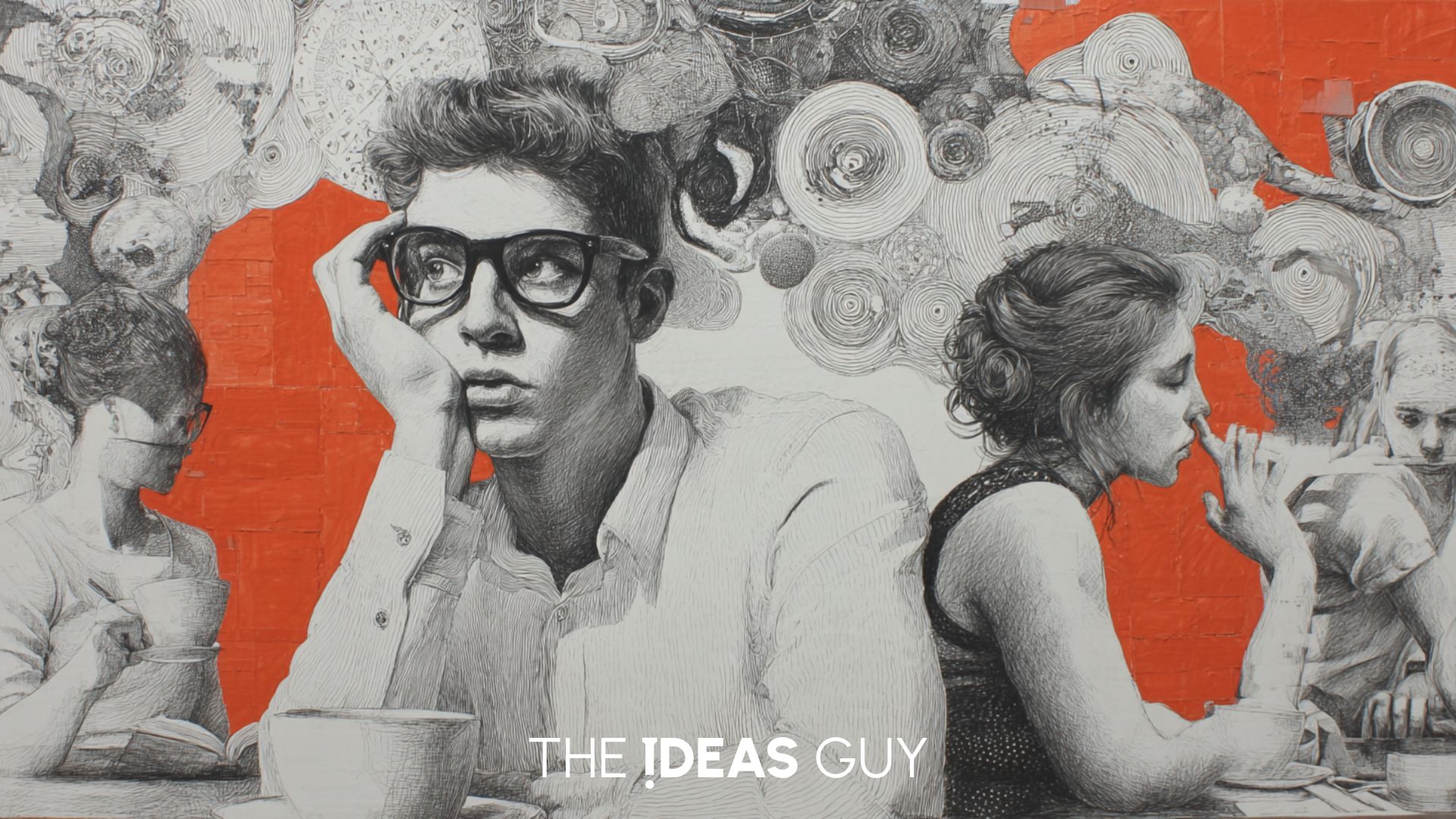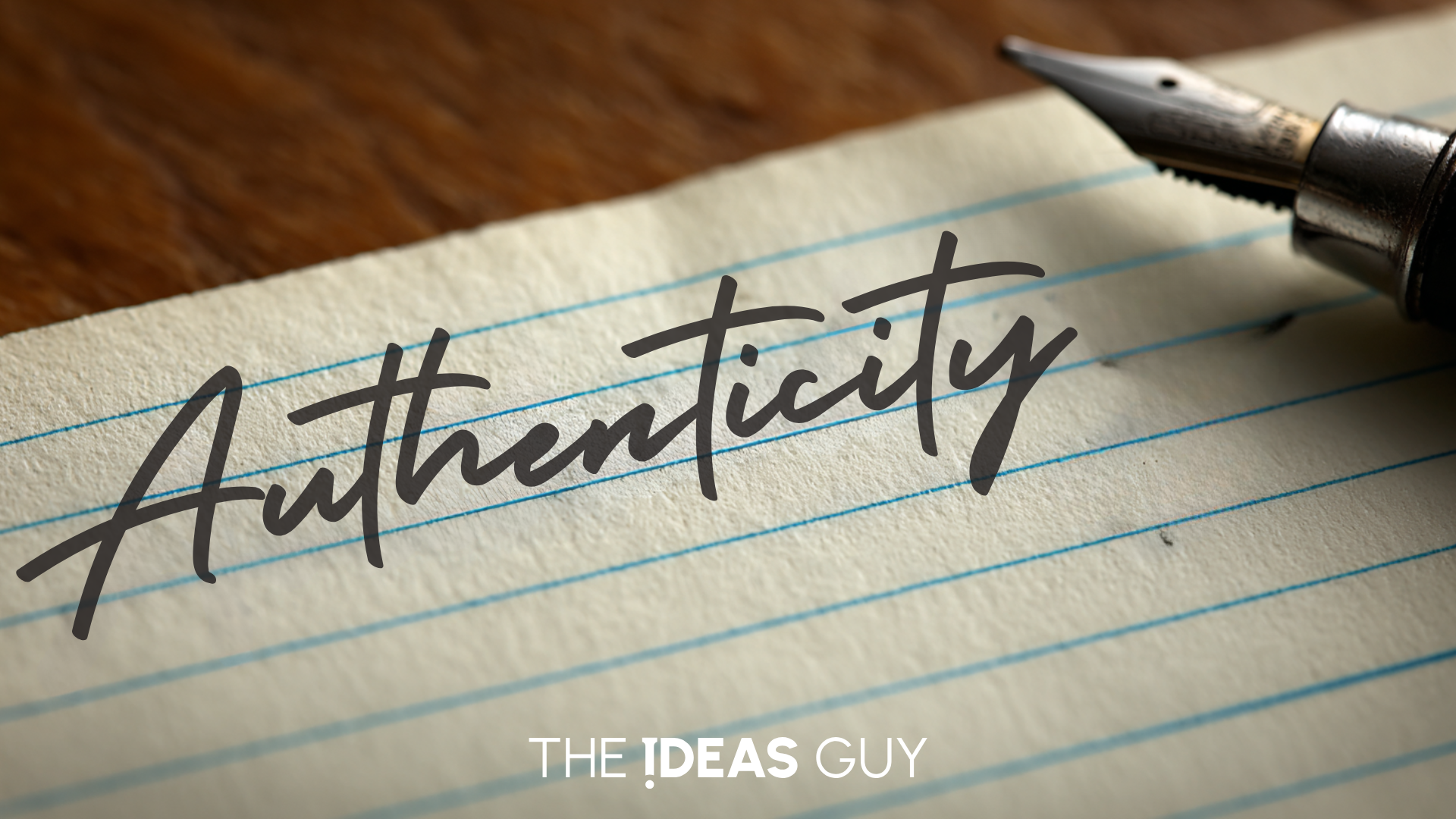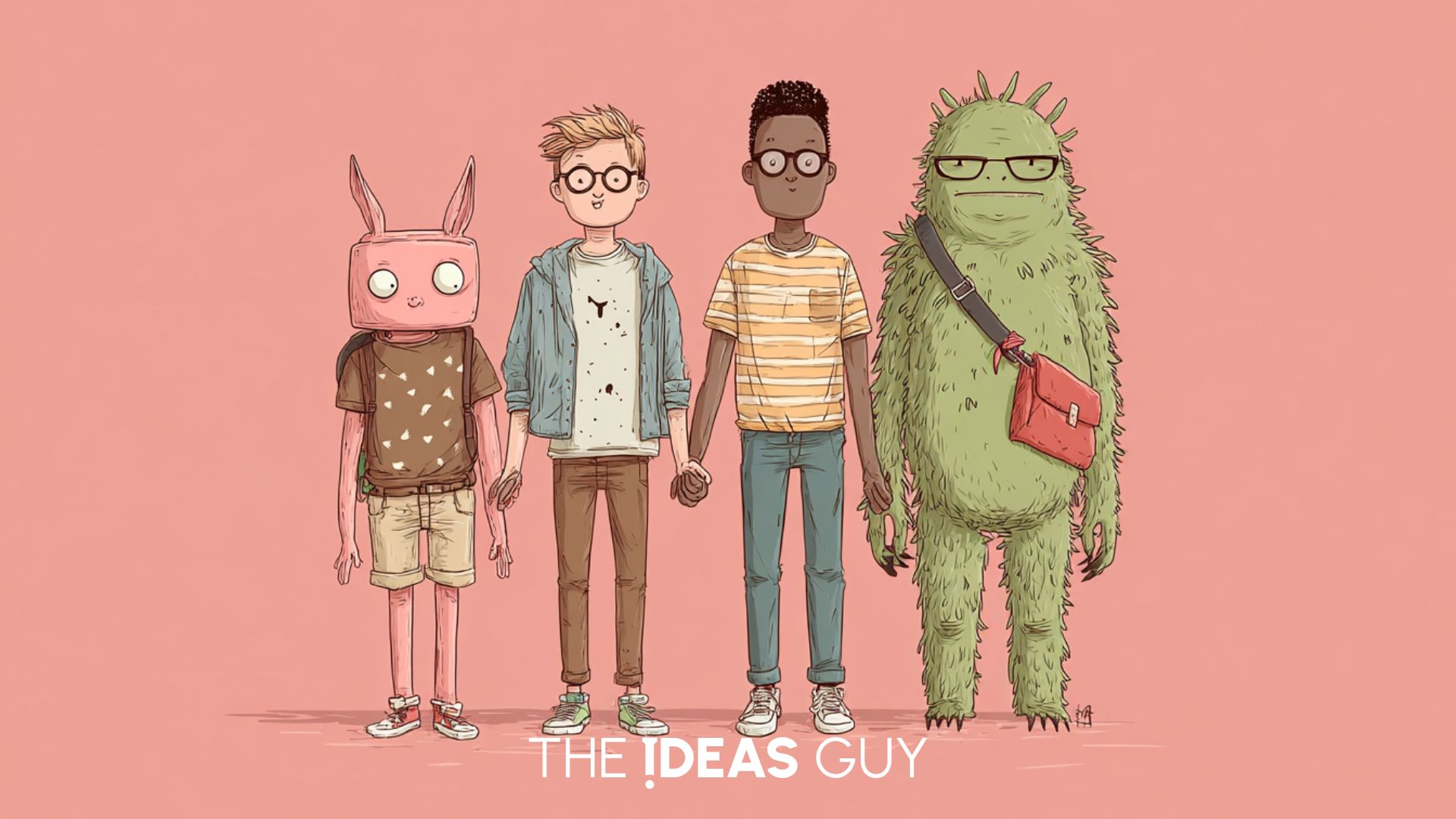Last week, I found myself at two very different social gatherings. The first was at an informal birthday gathering with a few close friends – the kind where conversation flows super easy, where silence feels comfortable rather than awkward, and where I could share a half-formed thought without fear of judgment. I left feeling energised, known and deeply myself.
The second was a networking event with roughly 80 people – professionals, acquaintances, and strangers united by the flimsiest of professional connections. Despite being naturally outgoing (to say the least!), I left drained, having performed what felt like a carefully choreographed dance of small talk and strategic positioning. I was charming; certainly. Engaged; absolutely. But authentic? Hardly.
The contrast troubled me. Why could I be completely myself with a few people but become a performer with 80? Why did expanding the group by a factor of about ten not just diminish my authenticity but seemingly obliterate it entirely?
The answer I think lies in an uncomfortable truth that modern life systematically ignores: our capacity for authentic connection has biological limits that no amount of social media connectivity or networking prowess can overcome. We are creatures designed for small-scale intimacy trying to function in a world that demands infinite scalability.
Hannah Arendt on Plurality and Authentic Action
The German-American political philosopher Hannah Arendt, who I seem to quote a lot in my articles, understood something profound about human authenticity that we've largely forgotten. In The Human Condition, she argued that authentic action - the kind that reveals who we truly are - can only occur under what she called the "condition of plurality."

Arendt defines plurality as "the fact that men, not Man, live on the earth and inhabit the world," emphasising that "we are all the same, that is, human, in such a way that nobody is ever the same as anyone else who ever lived, lives, or will live." This isn't just philosophical wordplay – it's a recognition that authentic human encounter requires the simultaneous acknowledgment of our shared humanity and our radical uniqueness.
“Society is the form in which the fact of mutual dependence for the sake of life and nothing else assumes public significance and where the activities connected with sheer survival are permitted to appear in public.” Hannah Arendt
For Arendt, this creates a paradox at the heart of authenticity: we need others to become ourselves, but we need the right kind of others in the right kind of space. As she puts it,
"Action is the public disclosure of the agent in the speech deed." Hannah Arendt
We literally cannot know who we are without others to witness and respond to our authentic self-expression.
But there is a crucial insight which Arendt offers: not all social contexts allow for authentic action. She warns that when "homogeneity and conformity have replaced plurality and freedom," authentic self-disclosure becomes impossible. The very conditions that modern mass society creates - the pressure to present a uniform, scalable self across multiple contexts - are precisely the conditions that make authenticity impossible. In other words, if we are all the same, then we are not ourselves.
This connects directly to what I experienced at those two gatherings. The informal party preserved Arendt's condition of plurality, each person could be recognisably themselves while being part of a shared reality. The networking event, by contrast, demanded what she would recognise as the erasure of plurality in favour of professional homogeneity.
The Biological Architecture of Genuine Connection
But why does authentic connection seem to have natural limits? Why can't we simply scale up our dinner party indefinitely? The answer lies in research that began not with humans, but with our primate cousins.

In the 1990s, British anthropologist Robin Dunbar was studying the social groups of primates when he noticed something remarkable: the size of a species' social groups correlated directly with the size of their neocortex – the brain region associated with higher-order thinking. More sophisticated brains enabled larger, more complex social groups, but even this relationship had limits.
When Dunbar applied this correlation to humans, he predicted a "mean group size" of 148, casually rounded to 150. But Dunbar's insight went deeper than just the headline number. He identified a hierarchical structure to human relationships that reveals something profound about the cognitive architecture of authentic connection.
The research shows we typically maintain around 5 people in our innermost circle - those to whom we "devote about 40% of our available social time" - and about 15 people in our close circle, accounting for "another 20%" of our social energy. The next layer expands to around 50 meaningful connections, with the outer boundary at approximately 150 people we can know in any genuine sense.
These aren't arbitrary numbers. As Dunbar explains, the evidence shows this "very distinctive layered structure" appears consistently across "telephone calling networks, Facebook groups, Christmas card lists, military fighting units and online gaming environments." Even more remarkably, the pattern holds across history for church congregations, Anglo-Saxon villages as listed in the Domesday Book and Bronze Age communities associated with stone circles.
What this suggests is that our capacity for the kind of authentic connection Arendt described isn't culturally determined, it's biologically constrained. Each layer of relationship requires different types and amounts of cognitive and emotional resources. The more authentic the connection, the more demanding it becomes.
The Quality of Attention
The French philosopher Simone Weil, whose insights into the nature of authentic relationship rival Arendt's, understood why this biological architecture matters. For Weil, authentic connection wasn't just about being known; it was about the quality of attention we bring to knowing others.

Weil argued that attention "suspends the centrality of the self to allow for supernatural justice" and genuine encounter with another person's reality. This isn't the scattered, multitasking attention that characterises modern life, but what she called "complete attention" - a state of receptive awareness that "is like unconsciousness" in its total absorption.
“Attention is the rarest and purest form of generosity.” Simone Weil
Those who knew Weil personally attested to this quality. Many talked about how everything else dropped away when she was talking to you, and you became the single most important person in the universe for the entire time that your conversation with her lasted. This is what authentic attention looks like and it's immediately obvious why it can't be scaled infinitely.
Weil herself understood the limits of genuine friendship,
"To desire friendship is a great fault. Friendship should be a gratuitous joy like those afforded by art or life. We must refuse it so that we may be worthy to receive it; it is of the order of grace." Simone Weil
This isn't misanthropy either but it's recognition that authentic connection requires a quality of attention that is, by its very nature, finite.
For Weil,
"Friendship has something universal about it. It consists of loving a human being as we should like to be able to love each soul in particular of all those who go to make up the human race." Simone Weil
But precisely because genuine friendship embodies this universal love, it cannot be multiplied endlessly. Each authentic relationship requires us to encounter another person in their full particularity, something that becomes cognitively and emotionally impossible beyond certain limits.
The Dilution Effect
Understanding these philosophical and biological limits helps explain what I am starting to call the ‘dilution effect’. It’s the way authenticity becomes increasingly impossible as social groups expand beyond our natural capacity for genuine attention and plurality.

I know what happens in my own life when I try to maintain authentic connections beyond these natural limits. I begin to develop what psychologists call "relationship management strategies", essentially, different personas for different contexts. The version of myself I present to people I work with differs from the one I show to my male friends, which differs again from who I am with my family.
This isn't necessarily problematic in small doses. Humans have always adapted their behaviour to different social contexts. The problem emerges when the cognitive load of maintaining multiple personas becomes overwhelming. Research shows "no uniform association between perceptions of social connectedness and quantifiable social encounters" so having more connections doesn't make us feel more connected, and often has the opposite effect.
The modern digital age has amplified this dilution effect exponentially, as you would probably imagine. Social media platforms (and I actually heard Mark Ryan call them “just media now” but that’s for another article) promise infinite connectivity, but research reveals that "60% of our time on social media is spent talking to just our 5 closest contacts." Even digital natives, surrounded by hundreds or thousands of online connections, naturally revert to Dunbar's numbers when it comes to meaningful interaction.
This creates what we might call authenticity fatigue, which is the exhaustion that comes from trying to be genuinely present to more people than our cognitive architecture can handle. Instead of becoming more connected, we become more isolated, hiding behind increasingly sophisticated but inauthentic personas.
Aristotelian Friendship in the Age of LinkedIn
The ancient Greeks had a more sophisticated understanding of relationship quality than our modern networking culture. Aristotle distinguished between three types of friendship: those based on utility (what someone can do for you), those based on pleasure (what you enjoy together), and those based on virtue, what he called philia, or friendship proper.
Only virtue-based friendships, Aristotle argued, involved genuine mutual recognition and appreciation of each other's character. These relationships required time, shared experience, and the kind of attention that Weil described. Crucially, Aristotle recognised that such friendships were naturally limited as you simply cannot know enough people deeply enough to form authentic virtue-based bonds with hundreds or thousands of individuals.

Modern professional networking culture has largely abandoned this distinction, treating all social connections as potential sources of utility whilst using the language of friendship to describe what are essentially transactional relationships. LinkedIn encourages us to "connect" with people we barely know and to maintain these connections through algorithmic prompts and superficial interactions.
This isn't necessarily problematic when recognised for what it is: a tool for professional coordination rather than authentic relationship. The problem emerges when we confuse networking with genuine connection, and when the time and energy we invest in managing large networks of weak ties crowds out our capacity for the strong ties that actually sustain us.
The False Democracy of Digital Connection
Media platforms have sold us a seductive vision of democratic connection. It’s based on the idea that we can and should be authentically present to everyone, everywhere, all the time. This vision fundamentally misunderstands both the nature of authenticity and the conditions required for genuine human encounter.
Arendt's concept of plurality requires not just the presence of many people, but the preservation of their distinctiveness. The ‘algos’, however, systematically flatten this distinctiveness. Everyone becomes a profile, a collection of demographic data points and curated preferences. The very architecture of these platforms works against the recognition of radical uniqueness that authentic encounter requires.
Moreover, the scale of digital connection makes the kind of attention that Weil described impossible. When someone has 1,000 Facebook friends or 10,000 Instagram followers, the mathematical reality is that meaningful individual attention becomes vanishingly small. What emerges instead is broadcast communication, talking to everyone and no one simultaneously.
Research confirms this intuition: despite having access to vast networks, "the mean number of Instagram followers is 150, and research suggests that outside of our top 150 friends and family the other people that we follow are just acquaintances or people we have never met." Even in digital spaces designed for infinite scalability, we naturally gravitate toward numbers that reflect our biological constraints.
This creates a peculiar form of loneliness, surrounded by more potential connections than any human in history, yet feeling increasingly isolated from genuine encounters. The promise of digital democracy in relationships has delivered instead a kind of relational totalitarianism, where the demands of maintaining an online presence crowd out the time and attention required for authentic connection.
Where Authenticity Still Thrives
Despite the challenges of modern life, authentic connection hasn't disappeared but it's simply been pushed to the margins, thriving in contexts that respect rather than violate our natural limitations.

High-performing teams consistently exhibit Dunbar-appropriate sizes. Gallup Research shows that "specialised teams of around 5 people are optimal for maximum productivity" and that "teams can thrive at spans of control of 15+” but only with extensive experience. These teams succeed not despite their small size, but because of it. They are small enough for each member to know the others' strengths, weaknesses, and authentic contributions.
Some organisations have explicitly structured themselves around Dunbar's insights. Flight Centre, an Australian travel agency, "applied Dunbar's number when reorganising the firm into 'families' (stores), 'villages' (clusters of stores) and 'tribes' (aggregates of villages up to a maximum of 150 people)." Rather than fighting against human scale, they designed their corporate structure to work with it.
Religious communities provide another example. Research on church congregations reveals that "congregations that have only one leader usually have a number of participants that is around 150" and that "congregations of more than 150 members need structural subdivisions for the active participation of their members to occur." When spiritual communities grow beyond natural limits, they either fragment or develop hierarchical structures that inevitably distance members from authentic spiritual encounter.
The most successful movements in history have understood this principle intuitively. They grow not by expanding individual groups beyond their natural limits, but by reproducing effective small groups. Early Christianity spread through house churches that rarely exceeded Dunbar's numbers. Revolutionary movements organise into cells. Alcoholics Anonymous maintains its effectiveness by continuously splitting groups once they grow too large for intimate sharing.
The Cost of Ignoring Our Limits
What happens when we systematically ignore these biological and philosophical constraints on authentic connection? The costs are both personal and social, affecting not just our individual wellbeing but the fabric of community life.
Perceived and received connectedness may be independent but both the quality and quantity of connections may play a role in making people feel supported. And the relationship isn't linear; more connections don't automatically lead to feeling more supported. Beyond certain thresholds, additional connections can actually undermine the sense of authentic support.
The mental health implications are significant. It’s relatively well established that building and nurturing social connections involves prioritising quality over quantity, focusing on the depth and meaningfulness of relationships based on mutual trust, empathy, and understanding. When we violate this principle and we try to maintain too many connections at too shallow a level, we experience what researchers call "social fatigue" and increased rates of anxiety and depression.
This connects to broader social and political problems. Arendt warned that when authentic spaces for plural encounter disappear, we lose the capacity for democratic deliberation itself. When we can't sustain authentic relationships at human scale, we retreat into echo chambers and filter bubbles. We lose the capacity for the kind of genuine encounter across differences that democracy requires. The political polarisation and social fragmentation of our time isn't just about ideology; it's about the erosion of the social conditions that make authentic encounters possible.

Reclaiming Authentic Scale
So how do we reclaim authenticity in a world that systematically undermines the conditions required for genuine human connection? The answer isn't to retreat from social life entirely, but to become more intentional about the quality and scale of our relationships.
Weil's insight about friendship being "of the order of grace" points toward a crucial principle: authentic connection cannot be manufactured or scaled like a business process.
"We must refuse it so that we may be worthy to receive it." Simone Weil
This means learning to say no to social invitations that serve no genuine purpose, to networking events that consume energy without creating meaning, to digital platforms that promise connection whilst delivering isolation.
This requires relational curation or the conscious choice to invest our limited social energy in relationships that allow for authentic encounters rather than dispersing it across networks too large for genuine attention. It means recognising that every yes to a superficial connection is implicitly a no to deeper engagement with those who matter most. It’s about not trying to be everything to everyone, as the great Everclear song goes.
By embracing vulnerability, practising active listening, cultivating authenticity, fostering shared experiences, and investing time and effort, we can create meaningful relationships that enrich our lives. But these practices require focused attention and emotional energy, resources that become diluted when spread across too many relationships.
Arendt's insight about plurality offers another crucial principle: authentic communities preserve rather than erase distinctiveness. This means creating "spaces of appearance" where people can reveal who they are rather than conforming to predetermined roles or expectations. It means valuing difference and disagreement as signs of authentic encounter rather than problems to be solved.
Living Authentically in an Inauthentic Age
Perhaps the most radical act in our hyperconnected age is to accept our limitations and to acknowledge that we are creatures designed for small-scale intimacy rather than infinite connectivity. This isn't a failure of imagination or ambition; it's recognition of what makes us human.

The dinner party that leaves me energised and the networking event that drains me aren't just different social contexts – they represent fundamentally different approaches to human relationship. One respected the conditions required for authentic encounter; the other systematically undermined them.
It now means becoming more intentional about when and how we engage, more protective of the time and attention required for authentic connection, and more realistic about what different types of social interaction can and cannot provide. In a world that constantly pressures us to expand our networks, scale our presence, and optimise our social capital, choosing to honour the limits of authentic connection becomes a form of resistance. It's an assertion that we are not machines to be optimised but humans to be encountered, not problems to be solved but mysteries to be explored.
The path to authenticity doesn't run through endless expansion but through intentional limitation. It requires the wisdom to know when we've reached the boundaries of genuine attention and the courage to say no to everything beyond those boundaries. Only then can we say yes to the kind of deep, particular, transformative encounters that make us most fully human.
Key Takeaways
- Honour biological limits. Accept that authentic connection has natural constraints around 5 intimates, 15 close friends, 50 significant others, and 150 meaningful relationships. Working against these limits leads to authenticity dilution.
- Practice Weilian attention. Give complete, undivided attention to those in your inner circles rather than scattered attention to vast networks. Quality of presence matters more than quantity of connections.
- Preserve Arendtian plurality. Create and protect spaces where people can be genuinely distinctive rather than conforming to roles or personas. Authentic encounter requires recognition of uniqueness, not homogeneity.
- Curate rather than accumulate. Consciously choose which relationships deserve your limited social energy. Every shallow connection maintained is a deep connection foregone.
- Design for human scale. Structure teams, communities, and gatherings to respect natural limits rather than fighting against them. Effectiveness comes from working with our constraints, not against them.
- Resist digital false democracy. Recognise that social media's promise of infinite authentic connection is biologically impossible. Use these tools strategically rather than allowing them to crowd out face-to-face intimacy.
- Choose depth over breadth. Invest in fewer relationships but invest fully. The alternative - many shallow connections - leaves us feeling isolated despite being hyperconnected.
Your truest self doesn't emerge through connection to everyone, but through authentic experiences with the precious few who can see and respond to who you really are. Our humanity is found not in endless expansion but in conscious limitation.
Further Reading
Discover more interesting articles here.
.png)
.png)
.jpg)

